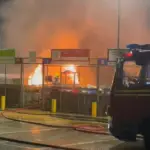Monday 30th September (6pm) is the deadline for having your say on Exxonmobil’s proposals to bury a CO2 pipeline across the Island, either from North to South or North to West.
The Solent CO2 Pipeline Project aims to connect Exxon Mobil’s Fawley oil refinery near Southampton to a designated CO2 storage site beneath the English Channel.
Local opposition
The plans have attracted huge opposition on the Island, with residents and many councillors all sharing their objections. The Isle of Wight Biosphere Committee have also expressed their concerns.
Isle of Wight West MP, Richard Quigley, has written to ministers with his concerns, and a petition launched by Christopher Davis has attracted almost 32,000 signatures.
If you use Facebook, a group for concerned Islanders has been formed called Say No to CO2 Pipeline across the IW. A range of views have been shared to the group along with useful information and links. A template objection letter prepared by Isle of Wight resident, Thomas Cowley (see below) has been shared for those who wish to object, but are struggling to get started.
A range of concerns
Many residents are concerned about the impact on the countryside, as well as natural habitats being destroyed. Others are worried about the impact of a potential leak – something that has happened before in other parts of the world.
NPR, a trusted news source in the US, reported last year on the leak of CO2 from a pipeline in Mississippi in 2020, which resulted in more than 200 people having to be evacuated from their homes and at least 45 people hospitalised. They reported that people lay on the ground, shaking and unable to breathe. The article is a fascinating read.
Nina Lakhani, a reporter in Louisiana, explained in the Guardian earlier this year, that CO2 is an asphyxiant and intoxicant, which in large quantities can cause injury or death by replacing oxygen in the air. She said that depending on the weather conditions, potent clouds of CO2 can hang in the air for hours. She was writing following a leak of around 2,548 barrels of carbon dioxide from an Exxon pipeline in Louisiana in April 2024.
Find out more
A series of public information sessions have been held on the Island and if you weren’t able to attend any of those, you can find the same information on the official website.
Exxonmobil say this pipeline project is the linchpin for establishing Carbon Capture and Storage (CCS) technology in southern England. It will be able to transport millions of tonnes per year of captured CO2, paving the way for carbon reduction developments at Fawley and across the region.

Have your say
The public consultation period closes at 6pm on Monday 30th September.
You can share your comments with the project team via the official website.
Objection template
Thomas Cowley shares below this objection template he created to help Islanders who wish to object, but are struggling to find the right words.
He suggests you make the response your own by enhancing it and adding your own concerns and email it before 6pm on Monday 30th September to [email protected] as well as copying in both Isle of Wight MPs ([email protected] and [email protected]).
Subject: Template response to Exxon Solent CO2 pipeline informal consultation
Full name:
Address:
I am responding to your consultation as an individual.
I am in favour of the concept of carbon capture as part of the path towards Net Zero goals, where there is no viable alternative.
I am absolutely against any of the three proposed pipeline corridors Exxon has put forward.
I do not believe Exxon’s informal consultation has been effectively communicated, or publicised to the general public, our elected representatives, or businesses that would be affected by the construction and operation of such a pipeline.
The timing of the consultation has prevented engagement with town and parish councils, New Forest District Council and the Isle of Wight Unitary Authority. It has also limited engagement with respondents who were either on holiday, or engaged in tourism industries at their busiest time of year.
Exxon has not offered sufficient alternatives, or provided enough data about the three corridors to allow people to form an informed view on the proposed project.
All of the proposed routes appear to destroy environments in designated landscapes: the New Forest National Park and the Isle of Wight National Landscape (formerly Area of Outstanding Natural Beauty). There has been insufficient information on how impact on these environments will be mitigated or restored. There has been insufficient information on how socioeconomic impacts will be mitigated, or compensated. This is totally unacceptable socially, environmentally and economically and will have a significant negative impact on many small businesses.
I believe the proposals fail to indicate both the route and methodology to be used beyond the immediate cliff-edge. Coastal communities have an interest beyond the land and activities in the water affect us too. We cannot make judgements on the overall project without this information. There is insufficient information explaining how activities will be impacted that are associated with workers including fishermen and divers and important leisure activities including beach tourism, sailing, kayaking, surfing and general tourism
The process of carbon capture by injection of CO2 recovered during oil and gas processing does not appear to be a process that is well established, or proven. Such a process extends the life of conventional fossil fuel processes, rather than encouraging new, less impactful processes to be developed.
This method of carbon capture has not demonstrated that it is effective at retaining CO2 in the ground, particularly not in the porous rocks in the proposed seabed site.
There are significant questions around the safety of transporting large volumes of asphyxiant gas, at extremely high pressure, by pipeline, across geologically complex, undulating landscapes.
There has been insufficient information on the lifetime of the project, once commissioned and the decommissioning and monitoring of the store post-decommissioning. Insufficient information has been provided on safety procedures and eventual compensation from injury or death resulting from, for example, a pipeline rupture.
Exxon have explained they do not know the storage capacity of the CO2 injection site and can only determine this by drilling on the proposed injection site.
I suggest that, should this project go ahead in any form, Exxon should establish any test injection site with an offshore rig. CO2 should be transported by sea-based, renewably-powered tankers at least until the capacity of the injection site is established, and preferably for the lifespan of the CO2 injection, removing the need for any pipeline construction.
This approach will prioritise protection of the irreplaceable landscapes above all, and enable Exxon to continue to process oil and gas if that is their chosen future technology. Our approach encourages Exxon to invest in finding non-CO2-emitting processes and products to replace their current fossil-fuel-based CO2 emitting processes and products.





